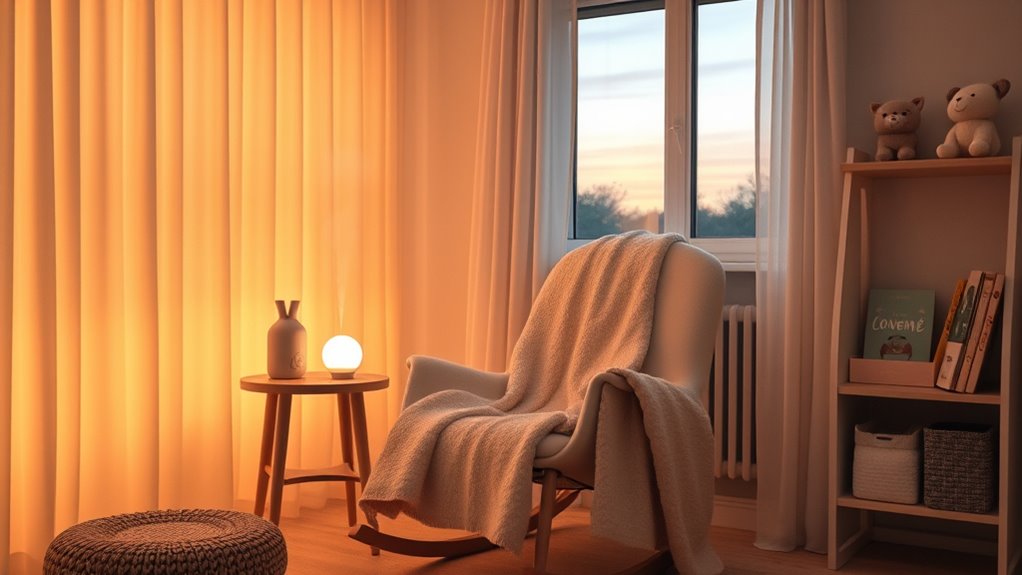To create a sleep-friendly evening routine for kids, start by dimming the lights and switching off screens at least an hour before bedtime. Incorporate calming activities like gentle stretching, quiet play, or listening to soft music to help bridge the change from active to restful states. Keep the routine consistent and predictable, with familiar steps such as reading or relaxation exercises. Pay attention to the bedroom environment, ensuring it’s quiet, comfortable, and inviting—learn more on how to perfect it.
Key Takeaways
- Establish a consistent bedtime routine with calming activities like reading or gentle stretching.
- Dim lights and turn off screens at least one hour before bedtime to promote melatonin production.
- Create a quiet, comfortable bedroom environment with minimal noise and soothing scents such as lavender.
- Incorporate relaxing sounds or white noise to help your child wind down and stay asleep.
- Use predictable, low-stimulation activities in the evening to reduce anxiety and signal that it’s time to rest.

Alongside bedtime stories, incorporating calming activities into your child’s evening routine can markedly improve their ability to wind down. Activities like gentle stretching, deep breathing exercises, or listening to soft music can help reduce any remaining tension or excitement. Keep these activities low-key and predictable, so your child knows what to expect each night. Dimming the lights and avoiding screens at least an hour before bed also plays an essential role, as the blue light emitted by electronic devices can interfere with melatonin production, the hormone that regulates sleep. Instead, opt for calming activities like coloring, puzzles, or quiet play, which help transition your child from active to restful states. Establishing a consistent routine helps signal to your child’s brain that it’s time to relax and prepares them for restorative sleep. Creating a calming environment in their bedroom also helps—dim lighting, a comfortable bed, and minimal noise support a restful atmosphere. If your child finds it hard to settle down, consider incorporating a relaxing scent, like lavender, in their room, or using a white noise machine to block out distractions.
Frequently Asked Questions
How Can I Handle Resistance to Bedtime Routines?
You can handle resistance to bedtime routines by making them enjoyable and engaging. Use calming music and bedtime storytelling to create a soothing atmosphere that your child looks forward to. Establish consistent, gentle boundaries, and give choices to empower them. When they resist, stay patient and calm, reinforcing positive feelings about bedtime. Over time, these calming elements will help ease their resistance and make the routine a comforting part of their night.
What’s the Ideal Duration for a Kids’ Evening Routine?
You should aim for a 20 to 30-minute evening routine to guarantee bedtime consistency and give your child enough time to wind down. Incorporate relaxing activities like reading or gentle stretching to signal that it’s time for sleep. Keep the routine steady each night, so your child knows what to expect, making it easier for them to settle down peacefully and develop healthy sleep habits.
How Do Screen Time Restrictions Affect Bedtime?
Screen time limits considerably improve bedtime consistency by reducing stimulation before sleep. When you set clear boundaries, your child’s brain can wind down more easily, making it easier to fall asleep and stay asleep. Limiting screens in the evening helps establish a predictable routine, which signals to your child that bedtime is approaching. This consistency fosters better sleep habits and guarantees your child gets the rest they need for ideal growth and development.
Can Dietary Choices Impact Sleep Quality?
Yes, dietary choices can impact your child’s sleep quality. Offering bedtime snacks with sleep-promoting foods like bananas, almonds, or warm milk helps calm their nerves and promote better rest. Avoid sugary or caffeine-laden snacks close to bedtime, as they can interfere with sleep. Incorporate these healthy options into your child’s evening routine to support restful sleep and guarantee they wake up refreshed and energized.
How to Adjust Routines for Different Age Groups?
You’ll find that adjusting routines for different age groups is easier than you think. Ironically, what’s age-appropriate for a toddler isn’t for a teenager, so you tailor activities like calming stories or quiet time for little ones and more independence for older kids. Keep routine consistency, but tweak activities to match their developmental stage. By doing so, you make bedtime smoother, and everyone gets better sleep—no magic required!
Conclusion
By establishing a calming, consistent evening routine, you set your kids up for better sleep and healthier habits. Remember, isn’t it worth creating a peaceful environment that helps them unwind and feel secure? With patience and persistence, you’ll notice your little ones drifting off more easily and waking up refreshed. So why not start tonight? Small changes can make a big difference in their sleep quality—and in your peace of mind too.









